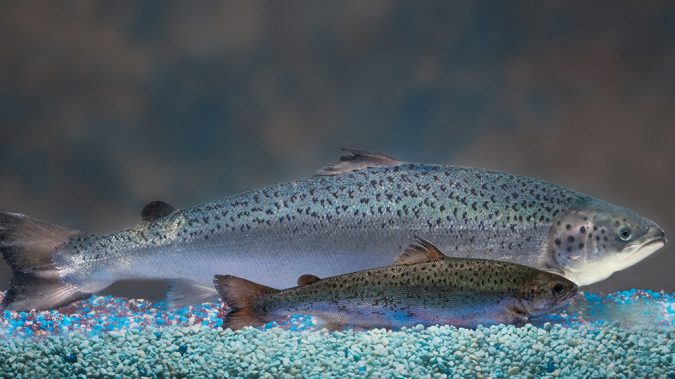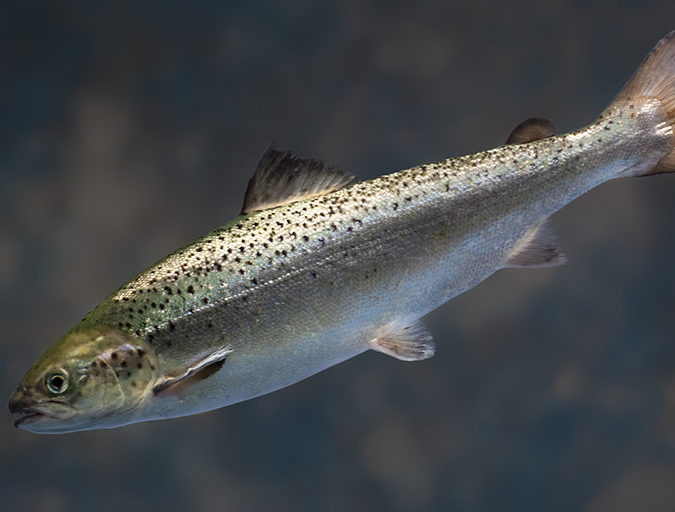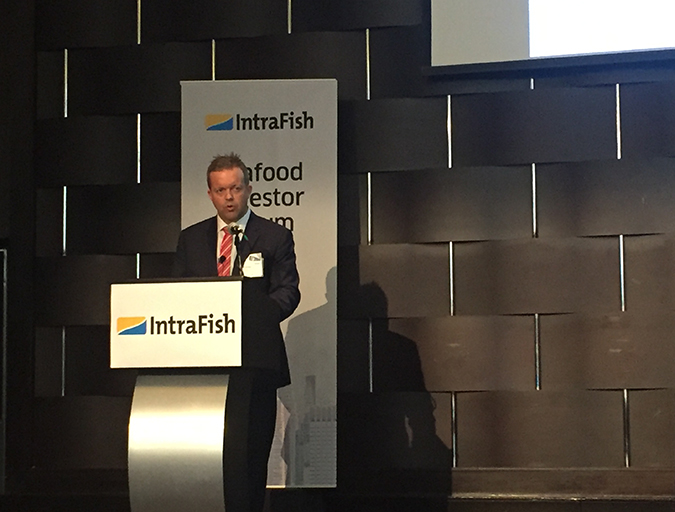‘Biotechnology presents the opportunity to improve the quality of life, the security of food and almost every aspect of our lives’

Ron Stotish is swamped. The CEO of AquaBounty Technologies – the company that aims to be the first to produce a genetically modified (GM) farmed salmon for the marketplace – has been busier than usual in recent months, thanks in part to two major wins that should signal the end of a two-decade-long saga marked with rigorous reviews, media scrutiny and vehement opposition from public-interest advocacy groups.
The first win came in November 2015, when the U.S. Food and Drug Administration (FDA) approved the company’s application for the production, sale and consumption of its fast-growing AquAdvantage salmon. Then, in May, just as Stotish was preparing to present at the IntraFish Seafood Investors Forum at the Grand Hyatt in New York, the news broke that Health Canada had also approved the augmented Atlantic salmon for sale.
It’s hardly time to lower the sails on the AquaBounty ship, however. A lawsuit in Canada, which alleged that the government did not follow its own regulations, was thrown out but is being appealed. And the Center for Food Safety has filed a suit in U.S. federal court claiming the FDA lacks the authority to rule on GM animal approvals. Stotish told the Advocate in an exclusive interview in mid-June that he’s confident of a positive outcome in both cases.
Let’s start with that moment in New York, as you were about to present at the IntraFish Seafood Investors Forum, when the news came out that Canada had approved AquAdvantage for sale.
That was a remarkable day. While I was at the conference the news came over the wire that the Canadian authorities, Health Canada, had approved our application for AquAdvantage in Canada. The IntraFish people thought I had staged it but nothing was further from the truth. That was a pleasant surprise and the timing was exquisite.
After a lengthy review process and much controversy, AquaBounty reached a couple of milestones in the past year. I’m sure you’re pleased with those developments, but now the real work begins in many ways. What are the next steps for your company, now that the FDA approved your application and Canada approved the product for sale?
As you suggest, in November of 2015 we received the FDA approval in the United States, and that of course was a watershed event. Then May 19, 2016, we got the Health Canada approval, which was the second major developed country to approve our product. Now, after this long wait and the difficulty of keeping the company going over all those years, we need to seek investors and partners and identify opportunities where we can put facilities and begin to grow our business.
AquAdvantage is an environmentally sustainable product. We can put production units closer to consumers and we think this is a wonderful opportunity. We’re in the process of talking to various groups and trying to put deals together now to really expand and grow this business.
Have your conversations with investors changed in the past six or seven months since the U.S. and Canadian governments declared your fish safe to eat?
Absolutely. The first question we always used to get no matter where we were and to whom we were talking was, “When will you receive approval?” Now that question has been answered. The conversations are much more direct. The first question that we generally get now is, “How much can I get and when can I get it?” That was a very pleasant turn of events for us. The industry, in particular the distributors, have been very interested in being able to access a sustainable and dependable source of supply. We’ve been pleasantly surprised by the general interest in the industry.
The FDA and Health Canada both concluded our product was the same as the traditional food, therefore did not require labeling. That should speak volumes to consumers about not only the safety of the product but the thoughtful, rigorous review process that was undertaken to reach those conclusions.
Do you envision your company becoming a primary producer, or the primary producer, or do you see your potential still best being met as a hatchery, selling the eggs to other land-based producers around the world to grow out and sell?
Well, we’ve looked at both models. A few years ago, if you were to ask me that question, I would have said we were a technology and genetics company. We’ve recognized that the real value in aquaculture is in the final food product. The short answer to your question is we’re looking and talking to potential investors and partners. The deals in various geographies may be different. We would like to find some way to participate in the value of the final product, whether that means joint ventures, partnerships, other business relationships or us trying to find ways to be the producers ourselves. We don’t have the final answer yet. I think in different areas of the world the answer may be different.
Much of the opposition to this fish, or the technology, or to genetically modified organisms in general, is fear of the unknown. AquAdvantage passed two different governments’ reviews for safe human consumption and environmental impacts. But how can you win over the marketplace?
I think it’s education. Perhaps the best way is to have the product available so that consumers can make the decisions themselves. Over the years, with all of the controversy and the difficulties that we’ve experienced, we’ve always taken the view that people have a right to choose and that people can choose to buy whatever products to feed their families that they’re comfortable with.
We hope, and there’s some evidence, in the sense that producers and distributors have accepted the fact that two of the most rigorous regulatory agencies in the world, in two highly developed countries, have reviewed this thoroughly over a long period of time and concluded that it’s identical to the traditional food and that it’s safe for consumers and safe for the environment. We think that has some value. In fact, on the Dr. Oz Show, he polled his audience expecting them to say they wouldn’t eat it. But one of the women said, “No, I would buy.” When he asked her why, she said, “Because FDA has approved it.” We think there will be some value there.
It’s interesting that the narrative from the people who have opposed us has not changed over the past 10 years. It’s basically the same old accusations, the same old fears that have been expressed over the years and that have largely been addressed by public documents from various regulatory agencies. We’re hoping that consumers are intelligent and try it for themselves and make their own decisions.
Key to that, of all the critical points in your story, it’s noteworthy that GM labeling would not be required in retail, according to FDA. In this age of transparency, why not just voluntarily label the fish as GM and stand behind it with a strong story?
We’ve given some thought to that. But at the moment we don’t have fish available so it’s not a problem we need to address immediately. Our concern has always been, and we’ve expressed this publicly over the years, that first of all labeling is a much broader issue than just AquAdvantage. It’s a controversial issue and the same sort of fear campaigns and marketing campaigns that have been run against us have been run against other products of technology and generally more for marketing advantage than for food safety or any other consideration. AquaBounty has always viewed voluntary labeling as good. Back in the days when we perceived ourselves as a technology company, we said repeatedly that if we sold eggs to customers we would encourage them to consider voluntary labeling.
Our big concern, overall and not just with our product but with other products, is that much of what is going on now is labeling-as-a-weapon and the process is being driven by groups with vested economic interests in disadvantaging products of this technology, whether they come from agriculture or, in our case, aquaculture. The label-as-a-weapon is a much different issue.

The FDA and Health Canada both concluded our product was the same as the traditional food, therefore did not require labeling. That should speak volumes to consumers about not only the safety of the product but the thoughtful, rigorous review process that was undertaken to reach those conclusions. Again, we could label our product as environmentally sustainable, healthy, local – all those things – and brand it. But if we’re the only labeled product then of course there’s always the potential that that label becomes a weapon against us from other producers seeking an economic advantage.
It’s a complex issue. For that reason, we’ve always taken the view that we’ll do as required, we’re still considering the possibility of branding our product, and we’ll make a decision when we have product available for sale.
You have a pretty vocal opposition in Washington, D.C., and I’m sure you’ve heard all the criticisms, fears about GM foods, and the nicknames. Still, how do you react when you hear the word “Frankenfish,” especially when it’s used by mass media outlets?
Over the years we’ve developed a sense of humor about it. It is a horrible, malicious adjective to describe our fish. It has its roots in the early days of this campaign, back in the early 2000s. The very verbiage and narrative is designed to instill fear and mistrust. Now we’ve gone through major regulatory review by two agencies, but unfortunately you can’t expunge the history because it’s become associated with the product. We hope that it will die away.
Our big concern, overall and not just with our product but with other products, is that much of what is going on now is labeling-as-a-weapon and the process is being driven by groups with vested economic interests in disadvantaging products of this technology.
How do I feel about it? I think it’s unfair, I know that it’s malicious. It doesn’t make me angry anymore because it’s a fact of life. We know we have a great product; we’re proud of our product and that we have achieved pioneering approval in two major countries. We believe that the quality of our product, and the consumer’s experience, will eventually allow us to get away from these sorts of adjectives and campaigns. I can promise you one thing, we will never brand our fish “Frankenfish” for sale!
Land-based, recirculating aquaculture systems, which your fish would be confined to by law, appeal to environmentalists who would like to see fish removed from ocean net pens. But while the technology is promising, there remain questions regarding the commercial viability due to high costs of production and operation, energy. You said in New York that AquAdvantage salmon could make the systems more competitive. Is it mainly because of the shorter life span?
That’s part of it. Let me begin by saying this is an irony of major proportions that many of the same groups who, on their websites and in public, profess to embrace land-based aquaculture have been the most vigorous opponents of AquAdvantage. That, I think, speaks to the motives behind these movements and organizations.
Land-based aquaculture has the potential, first of all, to put food closer to the consumer; it has the potential to eliminate the medication for sea lice; it has the potential to stop the spread of various diseases and pathologies that are endemic any time you have intensive production in sea cages anywhere in the world – and we’re all familiar with the examples, most recently the algal bloom in Chile, which was devastating and caused up to $1 billion in damages to an industry that had already been crippled by significant bacterial and viral diseases over the past 10 years.
Having said all of that, you’re quite correct that although the technology has improved and is improving every day, the slow growth rate of the very young fish makes the economics tight with conventional fish, even with fish that are improved by classical breeding. You can produce them economically, but if you have any adverse events at all, the economics are really very close.
AquAdvantage has two benefits: It grows much more quickly in the early life phases, so that when you’re running those pumps and using those utilities and feeding those fish, if that fish is growing at a rate 4 to 6 times faster than unmodified salmon, which is what we see in the early growth phase, you basically get 1 kilo of fish in eight or nine months instead of a year and a half. The rapid growth rate is a component in making those economics more attractive.
Second and perhaps almost as important is the improved feed-conversion rates that we’ve seen with AquAdvantage. This is typical with almost all animals that have growth hormone augmentation by whatever means, whether it’s injected or expressed within the animal. That improved feed conversion makes the animal more efficient. In our case, the published papers say 20 to 25 percent better feed conversion, which means 20 to 25 percent less feed to reach the same weight.
Those two factors really give us a competitive benefit in terms of cost of production. The most expensive component of raising salmon is the feed and the second is the capital cost and utility costs. If you can find areas where there are low utility costs – and there are certainly many of them, places that have hydro power or relatively inexpensive electricity – and if you can have a fish with the growth characteristics and the feed conversion characteristics of AquAdvantage salmon, you can have a lower cost of production, lower than even that of the sea cages.
Steve Jobs, near his death, was famously quoted as saying, “I think the biggest innovations of the 21st century will be at the intersection of biology and technology. A new era is beginning.” I’m not sure he had your fish or food in mind, necessarily, but was he right? And how do you characterize the potential of biotechnology as it pertains to global food supplies?
Biotechnology presents the opportunity to improve the quality of life, the security of food and almost every aspect of our lives. It’s being applied in [information technology] areas, living organisms functioning in IT networks, sort of living computers. It’s being used to improve cultivation in areas that are otherwise prohibitive or hostile. It’s being used to improve health in humans, to cure and prevent disease. Biotechnology has huge applications beyond just a faster-growing fish.
One of the reasons AquaBounty exists is that we believe application of modern molecular genetics, biotechnology and aquaculture is one of the great unfilled needs and one of the great opportunities to improve global food security.
Now that you've reached the end of the article ...
… please consider supporting GSA’s mission to advance responsible seafood practices through education, advocacy and third-party assurances. The Advocate aims to document the evolution of responsible seafood practices and share the expansive knowledge of our vast network of contributors.
By becoming a Global Seafood Alliance member, you’re ensuring that all of the pre-competitive work we do through member benefits, resources and events can continue. Individual membership costs just $50 a year.
Not a GSA member? Join us.
Author
-

James Wright
Editorial Manager
Global Aquaculture Alliance
Portsmouth, NH, USA[103,114,111,46,101,99,110,97,105,108,108,97,97,103,64,116,104,103,105,114,119,46,115,101,109,97,106]
Related Posts

Intelligence
GM salmon and the FDA: 10 takeaways
After a 20-year process, a genetically modified fish earned U.S. Food and Drug Administration approval, reigniting one of the seafood industry’s most intriguing controversies. Here are 10 key downloads from the groundbreaking decision over AquAdvantage salmon.

Intelligence
Science fact-checker debunks GM salmon criticisms
An article by FactCheck.org concluded that fears regarding risk to human and environmental health posed by GM salmon are unfounded. Meanwhile, a group of environmental NGOs has sued the U.S. Food and Drug Administration over its approval of the fish last year.

Innovation & Investment
Investors see (mostly) upsides in aquaculture’s outlook
Aquaculture is attractive to investors, but they remain wary of diseases that could stunt projections of massive growth. At the IntraFish Seafood Investors Forum in New York, discussion about the salmon industry and its challenges — antibiotics, genetically modified fish, Chile’s woes, sea lice — revealed both criticism and optimism.


